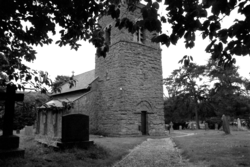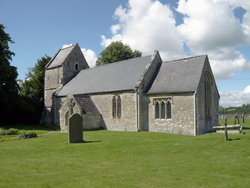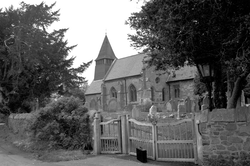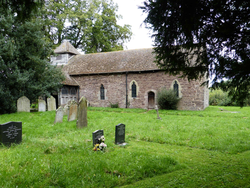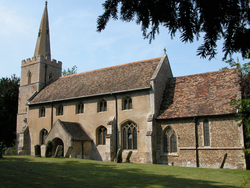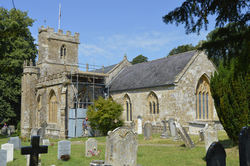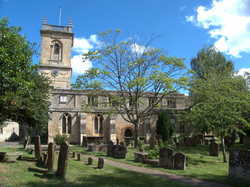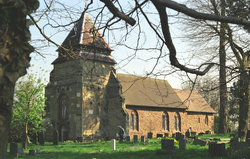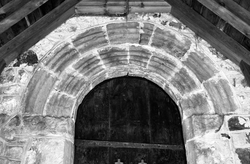
The Corpus of ROMANESQUE SCULPTURE in Britain & Ireland

St Mary Magdalene (now)
Parish church
Rothwell is a small village in the West Lindsey district of Lincolnshire, 9 miles N of Market Rasen and 2.5 miles SE of Caistor. The church is reached by a narrow path leading off School Lane, which runs S from the village centre. It has a late-11thc W tower of coursed rubble, a nave with 3-bay aisles added in the mid-12thc, and a chancel, which was restored in 1892 by J. D. Sedding.
Parish church
The manorial hamlet of Great Elm lies at about 100m OD on the L bank of Mells Stream just several kilometres downstream from Mells, among the hills of the E Mendips as they decline to the E. Less dominated than is Mells by limestone aggregate quarries because at their E limit, Great Elm occupies the N side of the Mells Stream valley just W of the large town of Frome. The church, which is built of random rubble, consists of a W tower, a nave with a S porch, a N transept and a chancel. Romanesque features recorded here are the blocked Norman doorway, partly obscured by the N transept, and the font.
Parish church
A red sandstone church with a nave and chancel mostly ofc.1200, a 14thc. S chapel and a W timber bell-turret. There is a plain round-headed doorway on the N side of the nave, and a doorway bearing Romanesque sculpture on the S. There is also a font of uncertain date but incorporating Romanesque features.
Parish church
Turnastone is a hamlet in the Golden Valley, in the South Herefordshire district. It is 10 miles W of Hereford and the nearest village is Vowchurch, less than half a mile to the E. The church has an aisleless nave and chancel in one with a low weatherboarded timber bell turret with a pyramid roof over the W gable and a timber S porch. There is a 12thc breccia font, but the S nave doorway of c.1200 is the oldest dateable fabric. The church is of decoratively coursed roughly-shaped sandstone and shows signs of work c.1300 (nave windows) and c.1500 (chancel doorway). There was a restoration by T. Edgar Williams of London in 1884.
Parish church
Extremely tall, five-bay nave with
clerestorey, N aisle and N and S porches. Much lower
aisleless chancel and W tower with octagonal stone
spire. The original (lower) nave and the chancel date
from c.1300 and the aisle and tower from the early 14thc. The clerestorey windows are Perpendicular, so the heightening of
the nave presumably dates from this time, but the exterior treatment makes it
difficult to be sure. The chancel and tower are
constructed of pebble rubble, the nave of stone rubble laid disturbingly like
crazy paving. The S side of the nave is mortar rendered. Inside, the
piers of the N arcade are of
Barnack stone and the arches of local clunch. There was a restoration in
1872-74 by J. Morley and J. Christian, and in 1926 the spire, having become
unsafe, was taken down along with the topmost storey of the tower. Rebuilding
was completed in the following year. The only 12thc. feature is the font.
Parish church
Only remnants of the N wall to the chancel of the 12thc church survive, together with a possible N doorway to the nave, and the font. The present building consists of a chancel, extended in the 13thc and rebuilt in the 15thc and 19thc; a 13thc nave; a late-14thc S porch and W tower; and an early 15thc S chapel with a 2-bay arcade into the nave.
Parish church
In the mid-C12th the Borough of Woodstock was founded by the king, and it is presumed that the present church was established at this time. It was created within the parish of Bladon as a chapel of ease. It is known that a S aisle was added in the C13th, and a bell tower, mentioned in 1279, stood on the N side of the church. This was rebuilt or raised in the C15th, but taken down as unsafe in the C18th. A new tower and N aisle were built in the classical style by John Yenn in 1784-6. The medieval church was almost completely rebuilt by A.W. Blomfield in 1878. Today the S doorway, richly decorated with two continuous orders of chevron, is the only Romanesque survival.
Parish church
Little Hereford is a village in the N of the county, half a mile from the Worcestershire border and a mile from the Shropshire border. The closest town is Tenbury Wells, 2 miles to the E, and Leominster is 6 miles to the S. The village stands on either side of the A456 that links Kidderminster to the main Ludlow to Leominster road. The River Teme flows past the southern edge of the village. St Mary's is at this southern edge, close to the river, and is dominated by its massive 13thc W tower. It has a large 13thc chancel, remodelled in the 14thc and a 12thc nave with a single surviving N window. An interesting survival is the arrangements for the rood altar, with a niche above the chancel arch and the remains of an entrance on the nave wall to the S. The only Romanesque feature here is the plain font.
Parish church
The church consists of a 12thc. nave and chancel and a 15thc. W tower with a Victorian timber top incorporating a pyramidal tiled roof. Surviving 12thc. features include two plain, round-headed lancets in the chancel (N and S walls) and one in the nave (N wall) as well as traces of what was originally a group of three round-headed windows in the E wall of the chancel. Only the outer jambs of this group is still discernable owing to the insertion of a larger, later window. There are also blocked doorways in the N and S walls of the nave. The jambs and arch of the original S doorway now form the W doorway to the tower. The font is also of the 12thc.
Parish church
Bolney church has an early 12thc. nave and a slightly skewed
chancel with a N chapel. The W tower was added in
1536-38, the N aisle in 1853 and the N vestry in 1912.
The S doorway of the nave dates fromc.1100.
